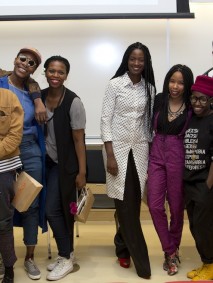Fashion Studies
Parsons School of Design's MA Fashion Studies
5 Takeaways from MAFS Student Rikki Byrd’s Essay on Racial Diversity in the Fashion Industry
We’re often the first to brag about the multiplicity of talents of our students. From their background experiences to extracurricular activities, work produced inside of our program to the plentiful and outstanding careers they take on after graduation, we pride ourselves in the excellence they commit to us. The goal of Parsons Masters of Art in Fashion Studies is to provide an immersive, intersectional and intellectual environment where our students can explore uncharted territory in the fashion industry, producing research that is just as enjoyable as it is informative.
With that in mind, we’re happy to announce that the research of Rikki Byrd, a first-year student who joined our program in August, has been published in the online journal Notices. Her research explores the intersections of race and fashion, acknowledging reoccurring themes between the two, such as lack of racial diversity in mainstream fashion publications and on runways, the coming-of-age of the black model, appropriation, racism, prejudices and more. Her latest essay, “Black the Color We Wear: The Temporality of Blackness in the Fashion Industry,” explores how the black body (and experience) is used in mainstream fashion as a trend that goes in and out of style. Below, we’ve selected our five favorite excerpts from the piece. You can read Rikki’s essay in its entirety on Notices.
To consider race and fashion is to consider how the former is reconstructed into an aesthetic statement. Much like a resort collection that is temporal in that it is meant for warmer weather and months, or coats and boots from a fall/winter collection, blackness is also used as a means of display and consumption.
Albeit the fashion industry was finally inclusive of black models in fashion, their blackness was still constructed into merely a moment; their identity as marketable would soon become packaged into trends that lent themselves to appropriation and lack of representation.
Racial progress seems to be a figment of imagination. The cyclical nature of racial oppression is more evident now than ever. Recent marches and protests in support of Ferguson and against police brutality greatly resemble marches from the Civil Rights and Black Power movement. Even the fashion industry seems to have returned to marking the difference of blackness and codifying its representation.
As the democratic atmosphere of the Internet permits, many continue to spread the word of the negligence in diversity and the misuse of blackness, which continues to situate the constructed race of being black into a position of silence and powerlessness.
So often, blackness—and its gruesome history—can be rendered a garment that can easily be shed when a season no longer begs for its use. Regardless of its trendiness, its historical oppression and misrepresentation continues to be worn and experienced by those that it most truly represents–black Americans.




